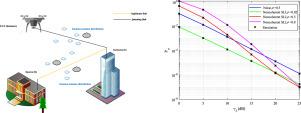ABER and outage probability of FSO systems under UAV-assisted symbol-level jamming over turbulent channels with pointing errors
IF 2.2
4区 计算机科学
Q3 ENGINEERING, ELECTRICAL & ELECTRONIC
引用次数: 0
Abstract
Free-space optical (FSO) communication systems are emerging as a viable technology for 6G, offering a compelling combination of cost-effective installation, high data throughput, extensive reach, and minimal latency. However, these systems are susceptible to potential intrusions, particularly jamming attacks, which pose a significant threat to their reliability and performance. We analyze the average bit error rate (ABER) and outage probability (OP) for phase-shift keying (BPSK)-modulated FSO systems under Unmanned Aerial Vehicle (UAV)-assisted jamming. The proposed system model includes both the legitimate and jamming channels, accounting for atmospheric turbulence (AT) and pointing errors (PE). The probability density functions (PDFs) of the signal-to-noise ratio (SNR), signal-to-jamming ratio (SJR), and signal-to-jamming-and-noise ratio (SJNR) are derived, which serve as the foundation for our ABER analysis. Closed-form expressions for the ABER and OP under BPSK modulation are derived for various jamming conditions, including coherent and non-coherent symbol-level jamming (SLJ), as well as noise jamming scenarios. Numerical analysis and Monte Carlo simulations are conducted to investigate the effects of AT and PE on system performance across various jamming conditions. Results indicate that AT in the legitimate channel significantly impacts system performance, with coherent SLJ yielding higher ABER than non-coherent SLJ. The phase difference between jamming and legitimate signals critically influences jamming effectiveness, where orthogonal phases minimize disruption. Furthermore, jamming signal pointing accuracy directly correlates with ABER degradation—higher precision induces elevated error rates. This study provides valuable insights for designing robust, jamming-resistant FSO systems.

具有指向误差的湍流信道上无人机辅助符号级干扰下FSO系统的ABER和中断概率
自由空间光(FSO)通信系统正在成为6G的一种可行技术,它提供了具有成本效益的安装、高数据吞吐量、广泛覆盖范围和最小延迟的令人信服的组合。然而,这些系统容易受到潜在的入侵,特别是干扰攻击,这对它们的可靠性和性能构成了重大威胁。分析了无人机辅助干扰下相移键控(BPSK)调制FSO系统的平均误码率(ABER)和中断概率(OP)。该系统模型考虑了大气湍流(AT)和指向误差(PE),包括合法信道和干扰信道。推导了信噪比(SNR)、信噪比(SJR)和信噪比(SJNR)的概率密度函数,为ABER分析奠定了基础。推导了BPSK调制下各种干扰条件下的ABER和OP的封闭表达式,包括相干和非相干符号级干扰(SLJ)以及噪声干扰情况。通过数值分析和蒙特卡罗仿真研究了不同干扰条件下AT和PE对系统性能的影响。结果表明,合法信道中的AT显著影响系统性能,相干SLJ比非相干SLJ产生更高的ABER。干扰信号和正常信号之间的相位差严重影响干扰效果,其中正交相位使干扰最小化。此外,干扰信号指向精度与ABER退化直接相关,精度越高,错误率越高。本研究为设计稳健、抗干扰的FSO系统提供了有价值的见解。
本文章由计算机程序翻译,如有差异,请以英文原文为准。
求助全文
约1分钟内获得全文
求助全文
来源期刊

Physical Communication
ENGINEERING, ELECTRICAL & ELECTRONICTELECO-TELECOMMUNICATIONS
CiteScore
5.00
自引率
9.10%
发文量
212
审稿时长
55 days
期刊介绍:
PHYCOM: Physical Communication is an international and archival journal providing complete coverage of all topics of interest to those involved in all aspects of physical layer communications. Theoretical research contributions presenting new techniques, concepts or analyses, applied contributions reporting on experiences and experiments, and tutorials are published.
Topics of interest include but are not limited to:
Physical layer issues of Wireless Local Area Networks, WiMAX, Wireless Mesh Networks, Sensor and Ad Hoc Networks, PCS Systems; Radio access protocols and algorithms for the physical layer; Spread Spectrum Communications; Channel Modeling; Detection and Estimation; Modulation and Coding; Multiplexing and Carrier Techniques; Broadband Wireless Communications; Wireless Personal Communications; Multi-user Detection; Signal Separation and Interference rejection: Multimedia Communications over Wireless; DSP Applications to Wireless Systems; Experimental and Prototype Results; Multiple Access Techniques; Space-time Processing; Synchronization Techniques; Error Control Techniques; Cryptography; Software Radios; Tracking; Resource Allocation and Inference Management; Multi-rate and Multi-carrier Communications; Cross layer Design and Optimization; Propagation and Channel Characterization; OFDM Systems; MIMO Systems; Ultra-Wideband Communications; Cognitive Radio System Architectures; Platforms and Hardware Implementations for the Support of Cognitive, Radio Systems; Cognitive Radio Resource Management and Dynamic Spectrum Sharing.
 求助内容:
求助内容: 应助结果提醒方式:
应助结果提醒方式:


